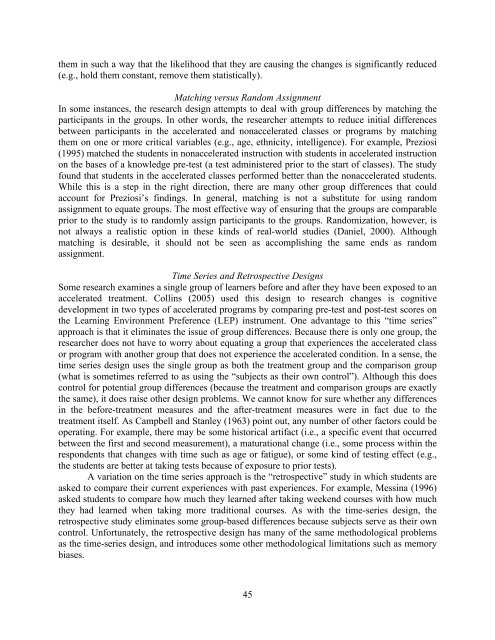Journal of Research in Innovative Teaching - National University
Journal of Research in Innovative Teaching - National University
Journal of Research in Innovative Teaching - National University
You also want an ePaper? Increase the reach of your titles
YUMPU automatically turns print PDFs into web optimized ePapers that Google loves.
them <strong>in</strong> such a way that the likelihood that they are caus<strong>in</strong>g the changes is significantly reduced<br />
(e.g., hold them constant, remove them statistically).<br />
Match<strong>in</strong>g versus Random Assignment<br />
In some <strong>in</strong>stances, the research design attempts to deal with group differences by match<strong>in</strong>g the<br />
participants <strong>in</strong> the groups. In other words, the researcher attempts to reduce <strong>in</strong>itial differences<br />
between participants <strong>in</strong> the accelerated and nonaccelerated classes or programs by match<strong>in</strong>g<br />
them on one or more critical variables (e.g., age, ethnicity, <strong>in</strong>telligence). For example, Preziosi<br />
(1995) matched the students <strong>in</strong> nonaccelerated <strong>in</strong>struction with students <strong>in</strong> accelerated <strong>in</strong>struction<br />
on the bases <strong>of</strong> a knowledge pre-test (a test adm<strong>in</strong>istered prior to the start <strong>of</strong> classes). The study<br />
found that students <strong>in</strong> the accelerated classes performed better than the nonaccelerated students.<br />
While this is a step <strong>in</strong> the right direction, there are many other group differences that could<br />
account for Preziosi’s f<strong>in</strong>d<strong>in</strong>gs. In general, match<strong>in</strong>g is not a substitute for us<strong>in</strong>g random<br />
assignment to equate groups. The most effective way <strong>of</strong> ensur<strong>in</strong>g that the groups are comparable<br />
prior to the study is to randomly assign participants to the groups. Randomization, however, is<br />
not always a realistic option <strong>in</strong> these k<strong>in</strong>ds <strong>of</strong> real-world studies (Daniel, 2000). Although<br />
match<strong>in</strong>g is desirable, it should not be seen as accomplish<strong>in</strong>g the same ends as random<br />
assignment.<br />
Time Series and Retrospective Designs<br />
Some research exam<strong>in</strong>es a s<strong>in</strong>gle group <strong>of</strong> learners before and after they have been exposed to an<br />
accelerated treatment. Coll<strong>in</strong>s (2005) used this design to research changes is cognitive<br />
development <strong>in</strong> two types <strong>of</strong> accelerated programs by compar<strong>in</strong>g pre-test and post-test scores on<br />
the Learn<strong>in</strong>g Environment Preference (LEP) <strong>in</strong>strument. One advantage to this “time series”<br />
approach is that it elim<strong>in</strong>ates the issue <strong>of</strong> group differences. Because there is only one group, the<br />
researcher does not have to worry about equat<strong>in</strong>g a group that experiences the accelerated class<br />
or program with another group that does not experience the accelerated condition. In a sense, the<br />
time series design uses the s<strong>in</strong>gle group as both the treatment group and the comparison group<br />
(what is sometimes referred to as us<strong>in</strong>g the “subjects as their own control”). Although this does<br />
control for potential group differences (because the treatment and comparison groups are exactly<br />
the same), it does raise other design problems. We cannot know for sure whether any differences<br />
<strong>in</strong> the before-treatment measures and the after-treatment measures were <strong>in</strong> fact due to the<br />
treatment itself. As Campbell and Stanley (1963) po<strong>in</strong>t out, any number <strong>of</strong> other factors could be<br />
operat<strong>in</strong>g. For example, there may be some historical artifact (i.e., a specific event that occurred<br />
between the first and second measurement), a maturational change (i.e., some process with<strong>in</strong> the<br />
respondents that changes with time such as age or fatigue), or some k<strong>in</strong>d <strong>of</strong> test<strong>in</strong>g effect (e.g.,<br />
the students are better at tak<strong>in</strong>g tests because <strong>of</strong> exposure to prior tests).<br />
A variation on the time series approach is the “retrospective” study <strong>in</strong> which students are<br />
asked to compare their current experiences with past experiences. For example, Mess<strong>in</strong>a (1996)<br />
asked students to compare how much they learned after tak<strong>in</strong>g weekend courses with how much<br />
they had learned when tak<strong>in</strong>g more traditional courses. As with the time-series design, the<br />
retrospective study elim<strong>in</strong>ates some group-based differences because subjects serve as their own<br />
control. Unfortunately, the retrospective design has many <strong>of</strong> the same methodological problems<br />
as the time-series design, and <strong>in</strong>troduces some other methodological limitations such as memory<br />
biases.<br />
45

















